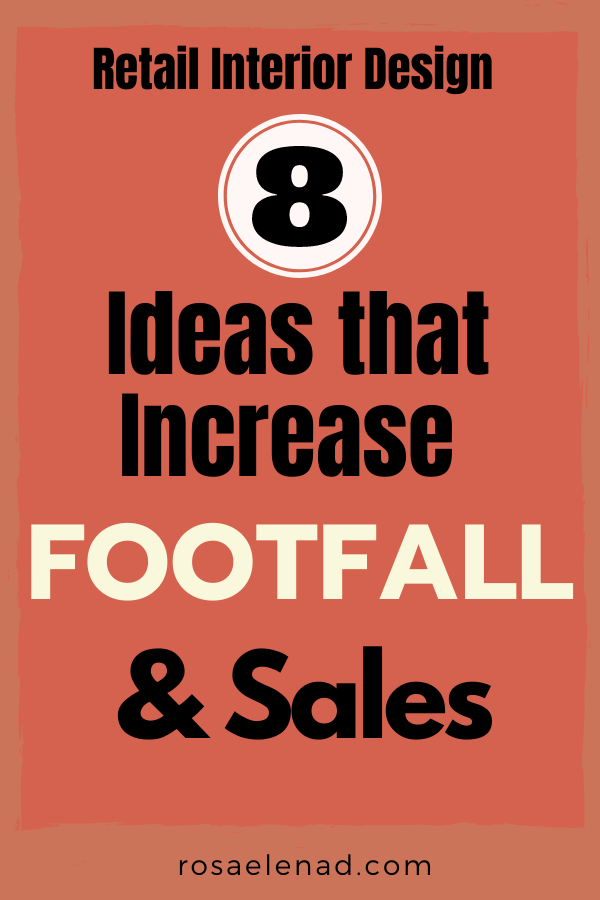Is your business losing customers? Have your customers ignored your merchandise? Does your shop get a lot of traffic, but hardly any sales? Do people scan your store from the entrance and leave?
According to visual merchandising expert Claire Langju Lee, small interior design changes—color, light, and space—in retail stores can increase sales significantly.
Claire Langju, author of Secrets Behind Things that Look Good, has worked in the retail world for over 23 years. Successfully, she has implemented small changes—color, light, and space—in retail stores to increase footfall and boost sales.
This post may contain affiliate links. Read my disclosure policy for more information.
Let’s dive in.

1. All that looks good is not easily forgotten: Create an image they’ll remember
How to get your customers to remember your brand or product.
Claire Langju expresses “memory is not created by effort, but by a sensory experience.”
Pick an accent color that represents your brand.
Repetition is important, “you must first embed it into their senses. If it isn’t remembered, it won’t be sold either.” To make your accent color memorable “use it in the same space at the same time on at least three spots in clear view.”
2. The golden ratio of colors: Green only makes up 5% of Starbucks’ colors
In this chapter, Claire Langju explains “accent color best practices, the golden ratio of color coordination, and basic properties of several major colors.”
“Balance looks good. What if there was a formula to creating this balance?”
Claire Langju explains you need three colors:
The dominant color: 70% of a design.
The secondary color: 25% of a design.
The accent color: 5% of a design.
3. Vision dictates your perception: How you arrange color can boost your sales
This chapter from Secrets Behind Things that Look Good is all about “How to arrange color in order to immediately draw a “that looks good” reaction from customers.”
“If you are worried about a product that isn’t making much of a splash, try leveraging complementary colors.” According to Claire Langju complementary colors help each other to stand out.
For example, Claire Langju noticed red apples on cardboard boxes ignored by customers. She bought a stem with large leaves, and “wrapped a few leaves around every apple for decoration.”
The contrast between red and green, a complementary color, “accentuated their freshness and captured people’s attention.” As a result, “with this simple change, the apples sold out quickly.”

4. How hot is your lighting? Color temperature can make or break your product image
This chapter presents the “essential role of color temperature in your home or business.”
Claire Langju explains how “specific light conditions make products look their best.”
For example: Claire Langju helped a spa that was losing customers.
The problem: She identified the problem at the powder room mirror; the light corresponding to a color temperature of 5,500k-which resembles daylight at midday. This light magnifies “any acne scars or fine wrinkles that customers might have would be more noticeable than ever.”
The solution: Replaced the light with a “three-wavelength lamps, creating a “subtle yellowish glow,…around 3,500k.”
“The Spa got its old customers back and a 50% membership increase within a week.”

Recommended:
4 Successful Sales Tips and Tricks That Will Make You a Sales Pro
5. Light is a seductress: Especially when it beckons in the dark
“By tinkering with the intensity of lighting, you can direct customers to a target location, have them spend more time there, and ultimately generate more sales.”
For example:
Claire Langju “piled a hundred bunches of spinach on each of two racks.” She illuminated one pile with a 400 lx light and the other pile with an 800 lx light. “The later pile sold twice as much.”
6. Lighting is an art of creating an illusion: Manipulate angle and height
In this chapter, the author considers lighting “not simply an instrument to light up space. It is your secret weapon to make a space look its best.”
For example: A situation Claire’s client went through:
“I get a lot of traffic in the shop, but hardly anyone ever buys anything.”
The problem: The fitting room that looks like a storage room, with ceiling lights that shine directly overhead, and mirrors that hang outside of each stall. “Nine times out of ten such fitting rooms drive customers away.”
The solution: “Tilt light downward at a 45-degree angle and set its color temperature to 3500 k for maximum effect.” Furthermore, to have a mirror in every cubicle-this has pro and cons for stores with limited space.
7. Store layouts that motivate shoppers to walk miles: Island displays prolong shopping time
A way to impact consumer’s behavior through visual merchandising is to consider the retail entrance layout, “The first six steps into the store are decisive.”https://www.pinterest.com/pin/290552613472913932/
For Example:
The problem: “People scan the store from the entrance and just leave.”
The solution: A treasure island near the entrance. “Try setting one up within six steps of the entrance, packing it with sales items, two-for-one promotions, or anything else shoppers might take an interest in.”
8. The ergonomics of merchandising: Secrets to spacing
“The key to store displays is to communicate the most meaning with the least amount of information.” Claire explains after you have worked color, light, layout, and still the store doesn’t look good the problem “might be having too many displays and advertisement.”
For example:
The situation: A Claire’s client—a ceramic shop—“was packed full of products, some of which were grouped by color and some by function. Some were displayed vertically and others horizontally.”
The solution: Claire advised, “vertical merchandising by color…, and spacing between each column, which is one way to practice the philosophy of emptiness.”
“The result? Without undergoing any major layout change, the shop managed to double its sales.”
“Understanding the pain and discomfort of others is the basis of a good retail display.”
9. A brand’s philosophy changes the lifestyle of customers
Why do businesses need a philosophy?
“Today’s consumers consider a lot more factors that they used to when purchasing a product.” For example: Ethical consumption. Brands generate profits and also serve a good cause.
For example: “Patagonia’s brand philosophy is…environmental and social responsibility.”
Their ad campaign 2011 was “Don’t buy this jacket.” Even though their strategy to boost sales seemed counterproductive, it worked, “many consumers who were in the market for a Jacket chose Patagonia, thinking they would rather buy from a company that makes the least impact on the environment.”
Buy here: Amazon US | Amazon CA | Amazon UK
Author Claire Langju Lee
Secrets Behind Things that Look Good: How Small Changes in Design Lead to a Big Jump in Sales
Published by Influential (August 22, 2017)
ARC by NetGalley








